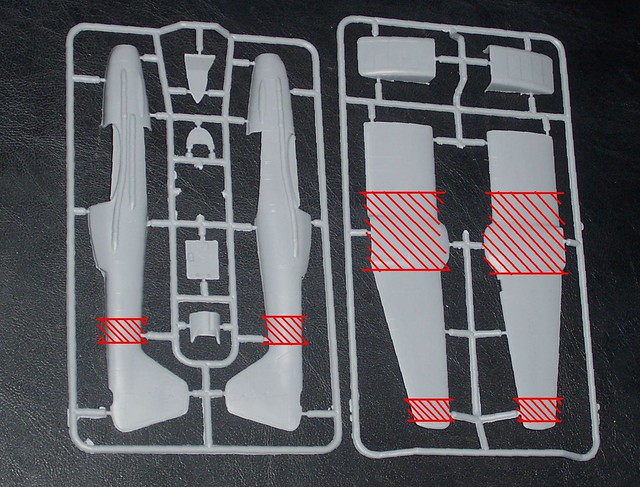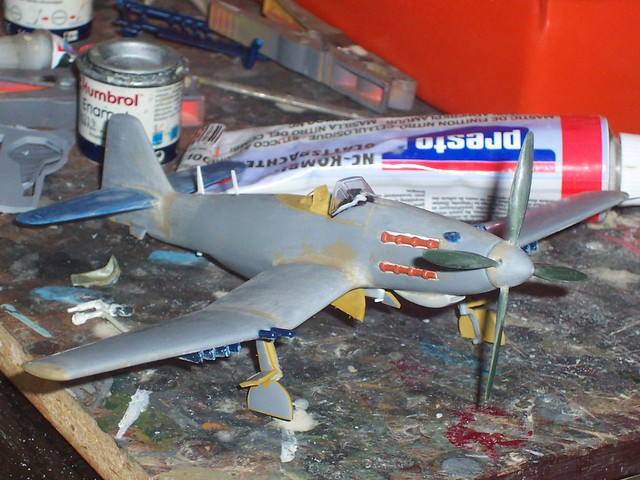Mal wieder ein Whif, das Ergebnis der Vorweihnachtszeit 2012, die fiktive Arsenal VB 31 “Requin”, ein schwerer Marinejäger aus Frankreich aus den späten 40ern. An dieser Stelle direkt der (rhetorische)Wettbewerb, was das denn mal war...? Sieht ja ein bisschen aus wie die unzüchtige amour fou einer Ju 87 mit 'ner P-51
 1:72 Arsenal VB 31 “Requin”, ‘8 White’, Flotille 12F, Aéronavale; Arromanches/Haiphong, October 1952 (Whif) - Beauty pic
1:72 Arsenal VB 31 “Requin”, ‘8 White’, Flotille 12F, Aéronavale; Arromanches/Haiphong, October 1952 (Whif) - Beauty pic by
dizzyfugu, on Flickr
 1:72 Arsenal VB 31 “Requin”, ‘8 White’, Flotille 12F, Aéronavale; Arromanches/Haiphong, October 1952 (Whif) - Beauty pic
1:72 Arsenal VB 31 “Requin”, ‘8 White’, Flotille 12F, Aéronavale; Arromanches/Haiphong, October 1952 (Whif) - Beauty pic by
dizzyfugu, on Flickr
 1:72 Arsenal VB 31 “Requin”, ‘8 White’, Flotille 12F, Aéronavale; Arromanches/Haiphong, October 1952 (Whif) - Beauty pic
1:72 Arsenal VB 31 “Requin”, ‘8 White’, Flotille 12F, Aéronavale; Arromanches/Haiphong, October 1952 (Whif) - Beauty pic by
dizzyfugu, on Flickr
Tatsächlich ist das eine umgebaute Bv 155 von Art Model aus Russland - die Inspiration kam, als ich Bilder von der französischen VB 10 (s.u.) sah und las, dass die Bv 155 eigentlich mal auf einem Trägerflugzeug-Konzept (die Me 155, die weiderum eine mutierte Bf 109 war) basierte. Warum also nicht ein Marine-Revival bei den Siegermächten, z. B. Frankreich?
Das Basismodell wurde gründlich verändert, u.a. die Flügel mehrfach gekappt und mit einem Möwen-Profil versehen, der Rumpf verkürzt und das Fahrwerk völlig neu positioniert, um stimmige Proportionen zu bekommen. Auch ein realer, experimenteller 24-Zyyinder-H-Motor aus der Zeit wurde verbaut...
 1:72 Arsenal VB 31 “Requin”, ‘8 White’, Flotille 12F, Aéronavale; Haiphong, October 1952 (Whif) - original kit sprue shot
1:72 Arsenal VB 31 “Requin”, ‘8 White’, Flotille 12F, Aéronavale; Haiphong, October 1952 (Whif) - original kit sprue shot by
dizzyfugu, on Flickr
 1:72 Arsenal VB 31 “Requin”, ‘8 White’, Flotille 12F, Aéronavale; Haiphong, October 1952 (Whif)
1:72 Arsenal VB 31 “Requin”, ‘8 White’, Flotille 12F, Aéronavale; Haiphong, October 1952 (Whif) by
dizzyfugu, on Flickr
Some background:The Arsenal (de l'Aéronautique) VB 31 was a French naval fighter aircraft developed shortly after World War II. In January 1947 Arsenal were given a contract to develop a powerful naval fighter for the four French aircraft carriers. Since the modernization of the Aéronavale was pressing, the aircraft had to be developed fast. In order to cut time, the initial concept, the VB 30, was based on the unrealized German Messerschmitt Me 155 project.

1:72 Arsenal VB 31 “Requin”, ‘8 White’, Flotille 12F, Aéronavale; Arromanches/Haiphong, October 1952 (Whif) by dizzyfugu, on Flickr
The Me 155 naval fighter had been a naval development of the Messerschmitt Bf 109G, intended for the German aircraft carrier Graf Zeppelin, which never saw the light of day. When it was clear that the Me 155 was a dead end, the basic design was developed further into a high altitude interceptor and the project handed over to Blohm & Voss. The resulting, highly modified Bv 155 saw the prototype stage in the late years of WWII, but was never put into service. Years later, though, the Me 155 should surface again: Evolved by Ingenieur-General Vernisse and M. Badie, the VB 30 did not only use many design features of the original Me 155 design, it also heavily drew on the indigenous VB 10 heavy fighter which had been previously under development since WWII.
The VB 30 was more compact than the VB 10, though, even though it had similar proportions. IIt was an all-metal single-seat fighter with a low-wing monoplane, a retractable tailwheel undercarriage and of largely orthodox configuration. The wings had an inverted gull wing shape, in order to shorten the main undercarriage as much as possible, and were foldable. The landing gear retracted inwards, and the tail wheel was retractable, too.

1:72 Arsenal VB 31 “Requin”, ‘8 White’, Flotille 12F, Aéronavale; Arromanches/Haiphong, October 1952 (Whif) by dizzyfugu, on Flickr
The VB 30's layout resembled much the smaller North American Mustang. The aircraft was powered by a powerful Arsenal 24 H engine which was theoretically capable of 3.400hp – itself a development based on the cylinder blocks of the German Junkers IV12 213 engine. A huge radiator bath for the liquid-cooled engine was located under the fuselage, at the wings’ trailing edge.
The aircraft was heavily armed, with a newly developed, compact 30mm cannon (which would eventually become the famous DEFA cannon), firing through the propeller axis, plus four HS-404 20mm cannons or six 12.7mm machine guns in the wings, outside of the propeller arc. Various ordnance loads, including bombs of up to 500 kg caliber, drop tanks or unguided missiles, could be carried under the fuselage and outer wings.

1:72 Arsenal VB 31 “Requin”, ‘8 White’, Flotille 12F, Aéronavale; Arromanches/Haiphong, October 1952 (Whif) - Cockpit detail by dizzyfugu, on Flickr
Unlike the huge, tandem-engined VB 10, the VB 30 was (relatively) more successful, but its career started under misfortunate stars: Just one month after the VB 10 contract was cancelled, the prototype VB 30-01 made its maiden flight on 8th of December 1948. Overall, the aircraft behaved well, but its low speed handling was hampered by the immense torque of the Arsenal 24 H engine and the huge, four-bladed propeller. This problem was eventually countered with an enlarged fin, which earned the type its nickname "Requin" (Shark).
With this and many other detail modifications the aircraft was now called VB 31and cleared for series production, even though it was already apparent that the future of the fighter lay with jet power. A second prototype, the VB 30-02, had been started, but its assembly lagged so much behind that it was eventually finished as the first serial VB 31. Anyway, the development of the VB 31 continued as a safety net for France's nascent jet fighter programs, since it was not clear when pure jets would eventually offer the appropriate performance for carrier use, and when they'd be ready for service.

1:72 Arsenal VB 31 “Requin”, ‘8 White’, Flotille 12F, Aéronavale; Arromanches/Haiphong, October 1952 (Whif) - Beauty pic by dizzyfugu, on Flickr
The VB 31’s development saw several drawbacks, including constant problems with the complicated, liquid-cooled engine, the radiator system and the landing gear. Serial production and service introduction of the VB 31 started slowly and was delayed until January 1951 – by which the French Air Force already had to rely on surplus British and American fighters to tide it over until domestically-produced jet fighters appeared. Time was already working against the VB 31.
Additionally, with the brooding Indochina War since August 1945, the need for a maritime fighter and fighter-bomber became so dire that the Aéronavale had to order the WWII Vought F4U-7 to fill this specific gap and replace several obsolete types. The XF4U-7 prototype did its test flight on 2 July 1952 with a total of 94 F4U-7s built for the French Navy's Aéronavale (79 in 1952, 15 in 1953), with the last of the batch, the final Corsair built, rolled out on 31 January 1953. With this proven (and cheaper) alternative, only a single batch of 40 VB 31 aircraft (instead of the planned 200!) was eventually built and put into service.

1:72 Arsenal VB 31 “Requin”, ‘8 White’, Flotille 12F, Aéronavale; Arromanches/Haiphong, October 1952 (Whif) by dizzyfugu, on Flickr
The VB 31 just came in time for the First Indochina War between France’s French Far East Expeditionary Corps and Emperor Báo Dai’s Vietnamese National Army against the Viet Minh, Led by Ho Chi Minh and Vo Nguyen Giap. During this conflict, the French used many different pre Cold War aircraft of World War Two, as well as the new types.The VB 31 were distrubuted between Flotille 3F and 12F, where they replayced Curtiss SB2C Helldivers and Grumman F6F-3 Hellcats, respectively. Flotille 12F pilots arrived in Asia on board of the aircraft carrier 'Arromanches' in early 1952, equipped with both VB 31 and F4U-7 fighters. Both types were deployed from the carrier and also served from Haiphong for CAS and escort duties in the Tonkin area.

1:72 Arsenal VB 31 “Requin”, ‘8 White’, Flotille 12F, Aéronavale; Arromanches/Haiphong, October 1952 (Whif) by dizzyfugu, on Flickr
The operational era of the VB 31 did not last long, though. The type was powerful, but complicated. The VB 31 also needed much more maintenance than the sturdy Corsair, which could also take more damage and had a considerable larger range. Hence, already in June 1953, all VB 31 were returned to Europe and based at Hyères, where they replaced obsolete F6F-5 Hellcats and were mainly used for training purposes. In the early sixties, with naval jet fighters finally available, the VB 31 were quickly withdrawn and scrapped, being replaced by Sud-Ouest SO-203 'Aquilon' (license-built D.H. Sea Venom) and Dassault Etendard IVM.General characteristics:Crew: one, pilot
Length: 11.63 m (38 ft 8 in)
Wingspan: 13.07 m (43 ft 6 in)
Height (peopeller at max. elevation): 4,9 m (16 ft 1 in)
Powerplant:1 × Arsenal 24 H, 2.260 kW (3.000 hp), driving a four-bladed propeller
Performance:Maximum speed: 665 km/h (413 mph)
Range: 1.191 km (740 miles)
Service ceiling: 11.125 m (37.100 ft)
Rate of climb: 10.2 m/s (2008 ft/min)
Armament:1× 30 mm cannon with 100 RPG, firing through the propeller axis
4× 20 mm HS-404 cannons with 200 RPG or 6×12,7mm machine guns with 250 RPG in the outer wings
1.500kg (3.300 lbs.) of external ordnance, including bombs of of to 454kg (1.000 lbs) calibre, drop tanks or up to eight unguided missiles under the outer wings.